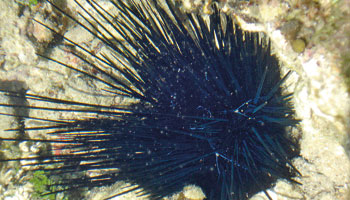The sea urchin population in many coastal areas is on the increase, and this could have a negative impact on recreational activities associated with the coast.
In certain areas, hundreds of these spiny creatures cover small areas of rock floor in shallow waters, presenting a risk to bathers, divers, and anyone who likes to go wading in the sea.
 |
| Diadema Savignyi |
A recent visitor came out of the sea with more than 400 sea urchin spines stuck in his body, according to marine biologist Dr. Terney Pradeep Kumara.
In another incident, a foreigner who had gone snorkelling in urchin-infested waters had to be taken to hospital to undergo surgery under general anaesthesic. Tourism could suffer a blow if the urchin invasion continues.
The sea urchin (ikiriya in Sinhala) is a spiny, hard-shelled creature that lives on the rocky seafloor, usually in shallow waters. The globular marine invertebrate has long sharp spines all over its body, and uses these needle-like growths to ward off predators. The spines inflict a painful wound if they penetrate human skin. The spines break when they go through flesh, which has to be cut open to remove the spine fragments.
The sea urchin population explosion is a result of an imbalance in marine ecosystems, says Dr. Kumara, who heads the Department of Oceanography and Marine Geology at the University of Ruhuna. Over-fishing and depletion in numbers of the Puffer fish – one of the sea urchin’s chief enemies – could be one reason for the abundance of the urchin.
The Puffer fish blows a powerful jet of water to dislodge the urchin off rock surfaces to which it attaches with the help of a muscle in its body. The Puffer fish then turns the defenceless urchin over and attacks its soft underside, which is not protected by spines.
Puffer fish numbers have dropped as a result of over-fishing and export. Marine pollution and marine ecosystem degradation are other factors that can exacerbate the problem.
Dr. Sevvandi Jayakodi of the Department of Aquaculture and Fisheries, at the Wayamba University of Sri Lanka, has conducted research on sea urchins along the southern coast. She says there are signs that stretches of shallow sea facing beach-front hotels have been systematically stripped of sea urchins “This can cause a further imbalance to an already imbalanced ecosystem,” she warned, pointing out that sea urchins are the main grazers and cleaners of rocky shore systems.
In other countries, the sea urchin is regarded as a friend that has helped to control invasive giant seaweed. The sea urchin is native to our oceans, and not an alien invasive species. As a part of our marine ecosystem, their removal could have repercussions.
Learn about ‘The Environment and You’
To mark its 30th anniversary, the Environment Foundation Limited (EFL) is holding a series of public lectures on the theme “Conserving our Marine and Coastal Treasures”.
The first lecture was given by Dr. Terney Pradeep Kumara, who spoke about the “Sea Urchin Invasion.”
The next two lectures will be on “The Economics of the Environment”, on December 8, and “Responsible Wildlife Tourism”, on December 15.
The lectures are open to the public, and held in the auditorium of the Dialog Future World Building, on T. B. Jaya Mawatha, Colombo 10 (near Excel World), from 5.30 pm to 7.00 pm. For more information, call EFL on 011-4528483. |


